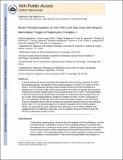Rictor Phosphorylation on the THR-1135 Site Does Not Require Mammalian Target of Rapamycin Complex 2
Author(s)
Boulbes, Delphine; Chen, Chien-Hung; Shaikenov, Tattym; Agarwal, Nitin K.; Addona, Terri A.; Keshishian, Hasmik; Carr, Steven A.; Magnuson, Mark A.; Sarbassov, Dos D.; Sabatini, David; Peterson, Timothy Richard; ... Show more Show less
DownloadSabatini_Rictor phosphorylation.pdf (1.685Mb)
OPEN_ACCESS_POLICY
Open Access Policy
Creative Commons Attribution-Noncommercial-Share Alike
Terms of use
Metadata
Show full item recordAbstract
In animal cells, growth factors coordinate cell proliferation and survival by regulating the phosphoinositide 3-kinase/Akt signaling pathway. Deregulation of this signaling pathway is common in a variety of human cancers. The PI3K-dependent signaling kinase complex defined as mammalian target of rapamycin complex 2 (mTORC2) functions as a regulatory Ser-473 kinase of Akt. We find that activation of mTORC2 by growth factor signaling is linked to the specific phosphorylation of its component rictor on Thr-1135. The phosphorylation of this site is induced by the growth factor stimulation and expression of the oncogenic forms of ras or PI3K. Rictor phosphorylation is sensitive to the inhibition of PI3K, mTOR, or expression of integrin-linked kinase. The substitution of wild-type rictor with its specific phospho-mutants in rictor null mouse embryonic fibroblasts did not alter the growth factor–dependent phosphorylation of Akt, indicating that the rictor Thr-1135 phosphorylation is not critical in the regulation of the mTORC2 kinase activity. We found that this rictor phosphorylation takes place in the mTORC2-deficient cells, suggesting that this modification might play a role in the regulation of not only mTORC2 but also the mTORC2-independent function of rictor. Mol Cancer Res; 8(6); 896–906.
Description
available in PMC 2012 January 1.
Date issued
2010-05Department
Massachusetts Institute of Technology. Department of Biology; Whitehead Institute for Biomedical Research; Koch Institute for Integrative Cancer Research at MITJournal
Molecular Cancer Research
Publisher
American Association for Cancer Research
Citation
Boulbes, D. et al. “Rictor Phosphorylation on the Thr-1135 Site Does Not Require Mammalian Target of Rapamycin Complex 2.” Molecular Cancer Research 8.6 (2010): 896–906. Web.
Version: Author's final manuscript
ISSN
1541-7786
1557-3125